
Arquivo para a ‘[:pt]Dispositivos[:en]Devices[:es]Dispositivos[:]’ Categoria
Androids has dreams?
The two films of Blade Runner were inspired by the book Androids dream of electric sheep ?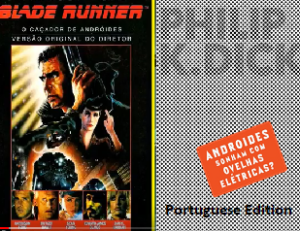 by Philip K Dick is reissued in 50-year commemorative edition (1968-2018) with unpublished writings: a letter from the author to the producers of Blade Runner in which prophesies the success of the production and the last interview granted by Dick, published in 1982 in the journal The Twilight Zone Magazine at the time of the launching of the film.
by Philip K Dick is reissued in 50-year commemorative edition (1968-2018) with unpublished writings: a letter from the author to the producers of Blade Runner in which prophesies the success of the production and the last interview granted by Dick, published in 1982 in the journal The Twilight Zone Magazine at the time of the launching of the film.
The exclusive preface signed by Argentine writer and journalist Rodrigo Frésan, a lover of science fiction and Dick’s work chronicling the troubled and impressive life of the author, and a brilliant scenarios they call “post-apocalyptic” by Douglas Kellner and Steven Best, professors respectively from the University of California and the University of Texas.
Add to this a postface written by the translator of the book, Ronaldo Bressane, who compares Androides with Blade Runner and comments on aspects of the work not explored in the cinema, such as environmental concern, besides the religious and metaphysical questions present in the text.
Religious and metaphysical issues are so current that they deserve an up-to-date view of what we think is our inner universe, our values and our relationship to the natural and yet transcendental world, in the non-immediate sense.
What is nature beyond nature and what is man beyond human is neither trans-nature nor trans-human only, but to look at it properly it will be necessary to have a transdisciplinary look, not to see from the side apocalyptic and pessimistic only.
Artificial Intelligence is undoubtedly an inspiration for the next few years, thinking of it is not thinking outside the spirit and human interiority, but it’s just questioning what it is, Blade Runner 2049 did this, but success was small, we preferred Robocop.
If inner life was reduced in modernity it is not due to current and upcoming advances, but due to the fact that sometimes we attribute to humans robots attitudes and not the opposite, because the current robots still have mechanical reasoning and a limited logic.
Agent environments and an example
The example that Norvig and Russel (2010) will give to describe what an environment in 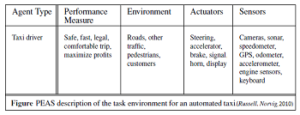 Artificial Intelligence is happy and unhappy at the same time, happy because it has become something real 8 years after the edition of the book, a taxi as a stand-alone vehicle, and unfortunate because there are already cases of accidents with autonomous vehicles.
Artificial Intelligence is happy and unhappy at the same time, happy because it has become something real 8 years after the edition of the book, a taxi as a stand-alone vehicle, and unfortunate because there are already cases of accidents with autonomous vehicles.
What is called environment is described as PEAS (Performance, Environment, Actuators and Sensors) (figure on the side), whose first stage is to design the task environment.
The agent will be different from a software (a softbot or webcrawler), but it is didactic.
The suggested environment was a stand-alone taxi, which at the time was “little beyond the capabilities of existing technology,” but on page 28 will describe a robot with this function, the fortuitous side of the example as the authors say is a ” completely open” and “there is no limit to the new combinations of circumstance that may arise”. (Norvig, Russel, 2010: 40)
What performance measures will be desired: arrive at the correct destination, minimize the correct destination time, fuel consumption and wear, traffic violations, disturbances and safety to passengers and other drivers, and if there are conflicts make decisions (this is one of the reasons for the accident to protect the passengers caused a hit by a passer-by).
The next step is to map an autonomous car environment, it must deal with a variety of roads, from rural lanes and urban lanes to 3, 4 and up to 5 lanes, with lanes, other vehicles, road works, police cars, puddles, and potholes, and should interact with potential and actual passengers.
Actuators for an automated taxi include those available to a human driver: control over the engine through the throttle and control over steering and braking. some optional choices of communication with other vehicles with arrows and even horn, and with passengers who will need voice synthesizers.
The basic taxi sensors will include one or more controllable video cameras so they can see the road; you can increase them with infrared or sonar sensors to detect distances to other cars and obstacles.
The problems of safety and conviviality with human drivers is evident, but thanks to this example of success made in 2010, today we have maps, GPS, road signs, and many others advances.
NORVIG, P.; RUSSEL, P. (2010) Artificial Intelligence: A Modern Approach 3nd ed., Upper Saddle River, New Jersey: Prentice Hall.
History of the algorithm
The idea that we can solve problems by proposing a finite number of 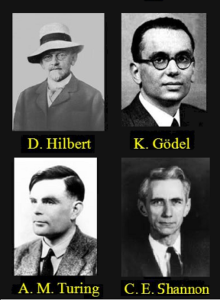 interactions between several tasks (or commands as they are called in computing languages) for several problems originates in Arithmetic.
interactions between several tasks (or commands as they are called in computing languages) for several problems originates in Arithmetic.
Although the machine of Charles Babbage (1791-1871) and George Boole’s (1815-1864) Algebra make a huge contribution to modern computers, most logicians and historians of the birth of the digital world agree that the problem of fact was raised by David Hilbert’s second problem (1962-1943) at a 1900 conference in Paris.
Among 23 problems for mathematics to solve, some recently solved such as Goldbach’s Conjecture (see our post), and others to solve, the second problem was to prove that arithmetic is consistent, free from any internal contradiction.
In the 1930s, two mathematical logicians, Kurt Gödel (1906-75) and Gerhard Gentzen (1909-1945) proved two results that called new attention to the problem proposed, both referring to Hilbert, so in fact, there is the origin of the question, roughly, if an enumerable problem is solved by a finite set of steps.
In fact, Gentzen’s solution was a proof of the consistency of Peano’s axioms, published in 1936, showing that the proof of consistency can be obtained in a system weaker than the Zermelo-Fraenkel theory, used axioms of primitive recursive arithmetic , and is therefore not general proof.
The proof of the inconsistency of arithmetic, called Gödel’s second incompleteness theorem, is more complete and shows that some proof of the consistency of Peano’s axioms can be developed without this arithmetic itself.
This theorem states: if the only acceptable proof procedures are those that can be formalized within arithmetic, then Hilbert’s problem can not be solved, in other more direct form, if the system is complete or consistent.
There are polemics raised about these results, such as Kreisel (1976) who argued that the proofs were syntactic for semantic problems, Detlefsen (1990) who says that the theorem does not prohibit the existence of a proof of consistency, and Dawson (2006) that the proof of consistency is erroneous using the evidence given by Gentzen and Gödel himself in 1958 work.
The controversies aside, Kurt Gödel’s participation in the important Vienna circle in the 1920´s before the war exploded, and the subsequent discussions of his theorem by Alain Turing (1912-1954) and Claude Shannon (1916-2001) underline its importance for the history of algorithms and modern digital computer.
A way forward in education
The basic basic education as stated in the first post of empathy, the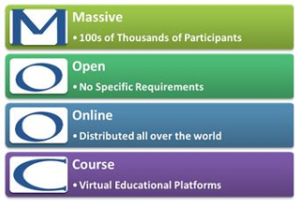 ability to resolve conflicts and it will not be possible with online education reach the levels of schooling for the lower age groups, but from the first schooling.
ability to resolve conflicts and it will not be possible with online education reach the levels of schooling for the lower age groups, but from the first schooling.
I call this age up to 10 or 12 years, it is possible to observe that online education helps and can be of great advancement, especially for children living in peripheral countries have a school performance capacity above what would be appropriate for their age, of course this child should enjoy normal channels of empathy and sociability of his age.
But at the higher level we can have higher quality jumps and provide high schooling on a world scale, just to give an example, India that still has alarming levels of health and poverty is a country that generates brains and high school students.
Massive Open Online Curses (MOOCs) is a type of open course offered through virtual learning environments, Web 2.0 tools or social networks that aim to offer a large number of students the opportunity to attend without physical presence in universities and without costs of housing, transport, etc.
A fake News ran this universe saying that the MOOCs were born in 2012 and died in 2014, but this is not true, the numbers prove this: the current numbers according to the Central-Class site, the number of online students is 58 million distributed in more than 700 universities, in 6850 courses, also the graphics of this site show increasing values.
In Brazil, large universities already have online courses, for example: FEA, from USP, has a course on Fundamentals of Administration (FEA / USP), available on the Veduca online education platform in Brazil. who wants to learn how to manage, another course is Social Responsibility and Sustainability of Organizations (PUC / RS), a PUC course in Rio Grande do Sul available in Miríada X, the Physics of São Carlos has The Basic Physics course (IFSC / USP) the course has a workload of 59 hours divided into 26 classes and UNB has the Bioenergetics course (UNB), which allows the interested party to choose to attend classes or obtain the certificate.
The (in) visible relations and networks
One of the issues in focus today is social networks, they are not of today, the problem is that today they are in evidence, but they continue to keep certain aspects of invisibility, confused with virtuality, make a historical analysis.
of today, the problem is that today they are in evidence, but they continue to keep certain aspects of invisibility, confused with virtuality, make a historical analysis.
The networks of commerce in antiquity, by sea and by land, the invisible colleges, defined by Solla Price in her work “The development of science: historical, philosophical, sociological and economic analysis” of 1976 (in Brazilian edition), calls the scientific networks of collaborative networks, where researchers communicate, exchange information and experiences, means that even in the absence, through printed works and conferences, authors collaborate.
Essentially, a network is a web of nodes and links between nodes, although these participants are autonomous, the consequences of network connections can exceed their own limits by connecting to “out” through weak links. In the analysis of networks can be identified only for didactic reasons, three types: ego networking, global networking networks and networks of actors relationships, called TAN (Theory Actor-Network) with origin in the works of Michel Callon.
Airport networks, container transport networks around the world, Global networks are strongly influenced by the media, and they create a certain amount of invisibility, since the collaborative networks of publications are also called invisible colleges by authors like Solla Price, but accelerated by the speed of the media, electronic media is larger speed of publication and communication that prints it, then blog, twitter and the social media media like Facebook occupy a new role at the present time, but are not in themselves networks, but networks media.
Several measures can be thought of, the centrality of closeness of an actor measures how close a node is to all others, the greater the proximity measure, the intermediation betweenness measures the importance of a node in the circulation of information. So, for information effect, betweenness is the measure of control that an actor holds in the flow of information and closeness is the facility that an actor has of access to information.
The invisibility, emphasizing present in the “invisible” colleges in modernity, is relative to the process of communication and information that can go beyond the actor actors along the network, virtuality in turn refers to the potentiality of increasing the capacity of the network
They aren´t deaf but not listen
The physiological fact of listening can be in contrast with the apprehension of the content in the human brain, that is, one can have a suitable hearing aid or even artifacts that help, but even listening, do not listen, that is, they do not apprehend the content.
apprehension of the content in the human brain, that is, one can have a suitable hearing aid or even artifacts that help, but even listening, do not listen, that is, they do not apprehend the content.
McLuhan’s view that communication as a medium tends to be defined as transparent, innocuous, unable to determine what are the communicative contents that are conveyed.
Its only effect on the artifact, whatever it was, in the communication process would be negative, due to noises or obstacles in the delivery of the message, this was already the preoccupation as a device of Claude Shannon, but now McLuhan calls either the message made orally or in writing, be it transmitted by radio, television, puts in play new structures being artifacts intended to broaden the senses highlighting contours and other nuances of what is communicated, in this work relates to the artist who wishes to highlight something.
Put more directly, for McLuhan, the medium, the cane (terms more appropriate for Shannon), the technology artifacts that communication establishes, is not only a form of communication, but will ultimately determine the own content.
What McLuhan points out is the fact that a message delivered both orally as in writing, when broadcasting on the radio or television sets the content.
Their central thesis is that there is a double operation: 1) to study the evolution of the communal media used by men throughout their history, and 2) to identify the specific characteristics of each of these different media / communication artifacts .
These are two central points of his investigation that are at the root of one of his fundamental works, namely Understanding Media, of 1964.
Thus develops three galaxies, when only one is remembered, the Gutenberg Galaxy, which is typical of the written culture and then printed with the possibilities of reproducibility, but there is the oral or acoustic cultural that is previous, where the question of listening is fundamental (orally speaking), oracles and prophets occupy a central role, and the present one that McLuhan called electronic, but it is possible as an extension to speak of a digital galaxy in network, where there are media of networks that do not must be confused with the networks, since they exist in the previous galaxies.
So those who are trapped in the Gutenberg galaxy do not listen to oral culture, and those who are trapped in the culture of pure technology do not listen to oral and written culture
Codified: For a Design Philosophy
Vilém Flusser was a Czech, brazilian citizen naturalized, died in 1991, who worked for about 20 years as professor of philosophy, journalist, lecturer and writer in Brazil and then back in his country of birth to the Czech Republic.
Republic.
His books are being republished in Brazil, including all his writings, and I began rereading The Coded World – for a philosophy of Design.
His work goes beyond the influences he received from Roland Barthes, Marshall McLuhan, because his philosophy is itself with elements of phenomenology and existentialism.
Rafael Cardoso’s introduction to the book highlights his change of thinking about the modern media he just saw born: “unlike most modern philosophers, who tend to focus their analysis on verbal language or mathematical codes, Flusser part of its gigantic power of reflection to images and artifacts, laying the foundation for a legitimate philosophy of design and communication. “(Flusser, 2017, p.10)
He asked deep questions about the virtual world: “If a tree falls into virtual space, and there is no one online, does it generate a warning message?” Returning to the famous question of the tree falling in the forest, the difference between the material and the immaterial? Can we exchange things for not things? “(Ibid.) And concludes with an even more fundamental question:” What destination should we reserve for the detritus generated by our frantic activity of transforming nature into culture? “(FLUSSER, 2017)
It approaches the paradigm of information, an essential basis for knowledge and education, “the end of history seems to be the end of our collective ability to fight against entropy, against the breakdown of meaning and form. If the basis of what we understand by culture resides in the action of in + form, then is not it paradoxical that the excess of information leads us to the breakdown of meaning? “(Idem)
The importance of the “concept of virtuality is perhaps the best and most elegant proof of how well Flusser was right.” (Ibid.), And can no longer escape this question, use in various forms of information, communication and the arts requires opening of this “black box”, the name of an essay published in the year 1985.
Flusser, unlike apocalyptics, admits that “at least in thesis,” which should become human well-being, becomes a slave to the forces of another “nature” which it helped to artificially generate. ”
Aspects of virtuality and a codified world are uniquely developed by the author and contribute to a more serene debate on new media.
FLUSSER, V. (2013) Shape of Things: A philosophy of Design, Reaktion Books, 2013. (pages and year em Brazilian edition).
Princess Leia: Back to the Future
I know, it’s two distinct films, but Brigham Young University (BYU) seems to return to the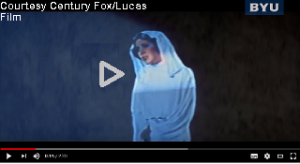 path of broadcasting and projecting 3D holographic images into the air.
path of broadcasting and projecting 3D holographic images into the air.
“Our team’s mission is to make the 3D holograms of science fiction a reality,” said Daniel Smalley, a professor of computational engineering and computer science, a holography expert who recently published an article in Nature magazine.
The technique he developed is based on the phenomenon of photophoresis, in which particles suspended in the medium of a gaseous liquid (there are experiments with droplets of water that forces it to be sucked into the air), it can be the particles that are in the air, which need to be moved by thermal gradients and can be done by laser beams, explains Smalley, “these screens are capable of producing images in a ‘fine beam’ that are visible from any direction and are not subject to cutouts,” ie seen from any position of the viewer.
The technical name of this effect is more precisely: “photophoretic-trap volumetric display”, and is superior to old techniques that could not capture light through the air to create a virtual object with the same notion of depth as the actual object.
But the most spectacular is the possibility of RGB projection (Red-Green-Blue, the three primary colors that composed were the visible spectrum by the human being) as the point of light is able to move quickly and thus the point of light produces the color, the projection of the green, red and blue laser radios produce the visual effect of the color.
The color image in three-dimensional volumetric (3D), will have the resolution of 10-micrometer (10 ^ -6 of the meter or 10 ^ -4 of the centimeter), this means to produce 10 thousand voxels (Pixels volumétricos) by centimeter or one million by meter cubic.
In a short time the communication has changed, in 10 years we have spoken through the Web in visual interaction, thanks to VoIP (voice over Internet), now the volumetric interaction in holograms, or also, to watch images of objects and people around us that are thousands of miles of distances, or simply in filming from other times, we are back in the future.
Heidegger and the Glade
The term is recurrent in philosophy, Plato spoke of leaving the cave to the light, in modernity appeared the Enlightenment, and more recently Heidegger spoke of the clearing (or Glade), meaning an opening in the middle of the forest, therefore, the question of the lack of light and dark night it is not new.
in modernity appeared the Enlightenment, and more recently Heidegger spoke of the clearing (or Glade), meaning an opening in the middle of the forest, therefore, the question of the lack of light and dark night it is not new.
But by studying the etymology of the Clearing, removing it from Heidegger’s philosophy, it comes from the German word Lichtung, where in addition to the meaning of a clearing in the forest (he himself lived a few years in the black forest of Germany), while Licht is the word for light , will mean hidden things, or entities whose truth must come to the surface, so some translators use unveiling.
The clearing is in this context what is hidden within a whole, where the being must emerge, and this seems more appropriate to modernity, since the fragmentation where only the part emerges is most often opposed to the whole to which the being belongs, thus the question of Being.
Thus the truth, for the present day, exists in the opening of the part to the whole, and the total closure of the part to the whole is sensed, not only as context, but as an integral part of Being, and to which openness is necessary to arrive the truth, not the affirmation concerning the object, but the primordial notion of the truth which is the discovery of the being in itself.
The entity that is discovered, stated Heidegger himself: “let it be seen in his being and being discovered. The truth-being (truth) of the statement must be understood in the sense of being a discoverer “(Heidegger, 1986, 219).
First we see this ontological truth as Being, and no longer as logic, as we see this relation between knowing the object and the relation to Being itself, which in modern philosophy could be called subjectivity, but it is not because they are not separate instances.
What is theorized here, in accordance with the anthropophysical theory in extension to sociotechnical, is that instead of treating the difference between thinking man as being that has “objects” in the sense of being possessed as the capacity to speak, and to construct “external” objects, the ontological conception that man thinks of as “being” through objects (the language and the production of his own life and the means necessary for it) allows us to understand all means not only as a vehicle for transmission of information, but as the mode in which human existence itself manifests itself, we call it onto-anthropothecnical.
In the photo, Andrew Kessel’s article for the magazine SingularityHub, experiments on real-life re-creation of computers by computers in 3D printers.
HEIDEGGER, M. Sein und Zeit. 17 ed. Tübingen, Niemeyer, 1986
Technology and bad news in 2017
The brazilian Minister of Technologies Gilberto Kassab announced in January this year that broadband would have limited data, and mobilization of users and even Anatel was immediate, also this month the good old Nokia (now global HMD) announced its membership in the Android system, which is becoming more universal.
January this year that broadband would have limited data, and mobilization of users and even Anatel was immediate, also this month the good old Nokia (now global HMD) announced its membership in the Android system, which is becoming more universal.
In January South Korean Samsung admitted the problems of explosions with Galaxy Note 7.
February was marked by a series of smartphones, such as the revived design of the Nokia 3310, without the same immediate success of the first generation the Pokemon Go hit the market.
In March Nintendo released the console Switch, the ZenFone 3 Zoom is released in Brazil, as well as the Galaxys S8 and S8+.
April was the month of the alert, the play of bad taste Blue Whale began to proliferate, there was also the case of the boy from Acre who left encrypted messages and disappeared.
May was the month of the ransomware virus WannaCry, which affected Telefonica Compay and FedEx, in 3 days the virus was neutralized, but the collection of bitcoins for captured files yielded a million probably the author has not yet been identified.
In June variations of the WannaCry affected possibly the origin has been in Russia.
In July, the virtual mural application Sarahah appears, the app is controversial because different from the spinners (virtual ads), allows the anonymity that can be source of blows.
In August Andy Rubin, considered the father of Android, launches the concept of Essential Phone, but like most Big Thing projects in the digital world, still lacks evolutions.
September was the same as the iPhone 8 and 8 Plus, as well as a commemorative edition of the iPhone X version ten years ago, but the Chinese Xiomi with Mi Mix 2 and ZenFone 4 appeared on the market.
September was the same as the iPhone 8 and 8 Plus, as well as a commemorative edition of the iPhone X version ten years ago, but the Chinese Xiomi with Mi Mix 2 and ZenFone 4 appeared on the market.
A new attempt at a revolutionary model was the GoPro Fusion (Picture), with a 360 degree camera.
October Google launches Pixel 2 and Pixel 2XL after the purchase of the HTC division.
November launched them to begin to rarify, but Razer launched the Razer Phone, and Tesla launched the semi-automatic and electric truck, but still subject to evolutions.
December brings the worst news, Trump’s idea of taking away the neutrality of the internet (companies would have more “band”) begins to thrive, would the end and total commodification be? we hope not, while technology fear is advanced, monopolies make the party.

